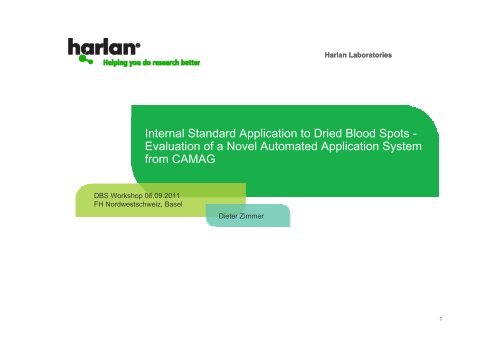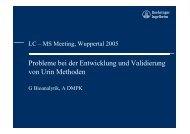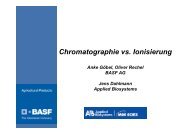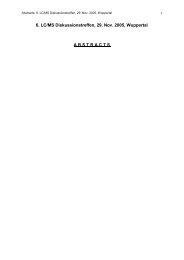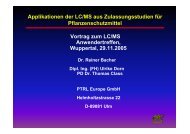Internal Standard Application to Dried Blood Spots ... - lc-ms.de
Internal Standard Application to Dried Blood Spots ... - lc-ms.de
Internal Standard Application to Dried Blood Spots ... - lc-ms.de
Create successful ePaper yourself
Turn your PDF publications into a flip-book with our unique Google optimized e-Paper software.
DBS Workshop 06.09.2011<br />
FH Nordwestschweiz, Basel<br />
Harlan Labora<strong>to</strong>ries<br />
<strong>Internal</strong> <strong>Standard</strong> <strong>Application</strong> <strong>to</strong> <strong>Dried</strong> <strong>Blood</strong> <strong>Spots</strong> -<br />
Evaluation of a Novel Au<strong>to</strong>mated <strong>Application</strong> System<br />
from CAMAG<br />
Dieter Zimmer<br />
1
Introduction<br />
• IS are ad<strong>de</strong>d in the extraction solvent for DBS analysis so far<br />
– IS not in liquid blood, nor penetrating in<strong>to</strong> dried blood<br />
– IS does not compensate for losses during sample preparation<br />
– IS compensates for matrix effects (SIL) and injection proble<strong>ms</strong><br />
• Alternative methods for IS addition are <strong>de</strong>sirable, <strong>to</strong><br />
– Mimick all effects acting on analyte as close as possible<br />
– Result in IS recovery similar <strong>to</strong> analyte<br />
• “IS Addition” subteam formed within the EBF “DBS <strong>to</strong>pic team”<br />
• Addition of IS by spraying was evaluated
CAMAG DBS-MS 16<br />
• Occasionally lent by CAMAG <strong>to</strong> HARLAN for the investigations performed there<br />
• First results presented at EBF Conference 2010 and ASMS 2011 (posters)
Homogeneity of Spraying on HPTLC Plates<br />
For equipment validation in HPTLC the following is done<br />
• 0.5 mg/mL Oracet Red G [1-(methylamino)anthracene-9,10-dione] in methanol<br />
used as a test dye for spraying<br />
• Spraying with the au<strong>to</strong>mated high precision sprayer ATS4 (CAMAG)<br />
• Merck 60 F254 HPTLC plates <strong>to</strong> measure the intensity variation of the<br />
spraying process<br />
• Analysis with an optical scanner (CAMAG TLC Scanner 4), <strong>de</strong>tection<br />
collima<strong>to</strong>r 4 x 0.3mm (length x width) in remission mo<strong>de</strong> at 546 nm<br />
A similar process was used for DBS, but with 14C coffeine mimicking an IS, and<br />
<strong>de</strong>termination by Imaging like QWBAR<br />
ATS4 HPTLC Sprayer DBS-MS 500 Sprayer
Homogeneity of Spraying on HPTLC Plates<br />
A finer gra<strong>de</strong>d HPTLC substrate was used<br />
• A centred circular area of 4.0 mm is used for extraction with the DBS-MS<br />
• Profile plots of the spray pattern (bars indicate 4 mm region).<br />
• Table with CVs of the integrated response of centred 4 mm area
<strong>Blood</strong> Spotting<br />
• Fresh rat whole blood (EDTA) s<strong>to</strong>red up <strong>to</strong> 10 days in freezer (5 o C)<br />
• 15 µL blood per spot (approx. 7 mm diameter)<br />
• Ahlstrom 226 cards, green (ID Biological Syste<strong>ms</strong>)<br />
• Drying for about 2 hrs at ambient temperature<br />
• S<strong>to</strong>rage in plastic bags at ambient temperature until analysis
IS Distribution by Spraying – The Concept<br />
• Scan von Rat slice und DBS Karte<br />
•
Homogeneity of IS Distribution on DBS cards<br />
• Cards were spotted with blank whole blood of rats<br />
• [1-Methyl 14 C] Caffeine (mimicking an IS) sprayed on<strong>to</strong> dried blood<br />
spots on cards with the high precision sprayer ATS4 (CAMAG)<br />
• Radioactivity and its distribution were <strong>de</strong>termined by Imaging<br />
• Homogeneity of IS distribution across the blood spot<br />
• Reproducibility between spots<br />
• Effect of the sprayed solution volume (5 – 40 µL) on reproducibility
Spraying with ATS4 (Au<strong>to</strong>matic TLC Sampler, CAMAG)<br />
• [1-Methyl- 14 C] Caffeine, MW 194.2 g/mol, mimicking an IS<br />
H 3<br />
C*<br />
O<br />
N<br />
O<br />
N<br />
CH 3<br />
N<br />
N<br />
CH 3<br />
• Specific Activity: 55 mCi/mMol = 11241 kBq/mg<br />
• Concentration in ethanol: 0.1 mCi/mL = 3.7 MBq/mL = 222 x 106 dpm/mL<br />
• Spray Solution: Target 14C concentration of 40000 dpm/20 µL<br />
• 60 µl [1-Methyl- 14 C] Caffeine <strong>Standard</strong> in 6 mL Methanol<br />
• Concentration measured: 3 Aliquots a 20 µl = 39448 dpm ± 0.9 %<br />
corresponding <strong>to</strong> 98.6% of Target<br />
• 10 x 10 mm area microsprayed (5 – 40 µL) covering the whole blood<br />
spot (see figures)
Determination of Radioactivity<br />
• BAS 5000 (Fuji Pho<strong>to</strong> Film Co. Ltd.)<br />
• Imaging Plate Type BAS III (20x25 cm) (Fuji)<br />
• Exposure: 18 hours, Resolution: 25 µm<br />
• Carbon-14 <strong>de</strong>cays in<strong>to</strong> nitrogen-14 through beta <strong>de</strong>cay (156 keV)<br />
• Betas are <strong>de</strong>tected up <strong>to</strong> a <strong>de</strong>pth of approximately 100 µm
Profiles Across <strong>Spots</strong><br />
Intensity [PSL]<br />
2<br />
1<br />
0<br />
0 1 2 3 4 5 6 7 8 9 10 11 12 13 14 15<br />
Position [mm]
Homogeneity of IS Distribution on DBS cards<br />
12.0 mm<br />
Intensity [PSL]<br />
20<br />
10<br />
12.0 mm<br />
4.0 mm<br />
4.0 mm<br />
0 1 2 3 4 5 6 7 8 9 10 11 12<br />
Position [mm ]<br />
Spray pattern analysis for 14C Caffeine on Alstrom 226 cards<br />
as function of sprayed volume: 2-dim plot with profiles for 20 µL/cm 2<br />
4.0 mm<br />
20<br />
Intensity [PSL]<br />
10<br />
0 1 2 3 4 5 6 7 8 9 10 11 12<br />
P osition [m m ]<br />
• 15 µL blood spotted ~7 mm<br />
• 10 x 10 mm sprayed with IS<br />
• 4 mm circle online extracted<br />
• Center located by laser beam
Radioactivity (PSL/mm²)<br />
Homogeneity of IS Distribution on DBS cards<br />
800<br />
700<br />
600<br />
500<br />
400<br />
300<br />
200<br />
100<br />
0<br />
Homogenity of <strong>Internal</strong> <strong>Standard</strong> applied as [14C] Spray<br />
Solution <strong>to</strong> DBS<br />
5 10 20 40<br />
Spay Volume [µL/cm²]<br />
Homogenity of Radiolabeled <strong>Standard</strong> applied as Spray Solution <strong>to</strong> DBS<br />
Spray Volume<br />
Radioactivtity<br />
Mean (n=8) S.D. CV<br />
[µL/cm²] [PSL/mm²] [PSL/mm²] [%]<br />
5 184.83 3.45 1.87<br />
10 274.83 7.40 2.69<br />
20 403.55 11.23 2.78<br />
40 664.79 39.23 5.90<br />
Spray pattern analysis for 14 C<br />
Caffeine on Alstrom 226 cards as<br />
function of sprayed volume:<br />
2 cards (8 spots) per volume<br />
Card B7 (5 µL/100 mm², 10000 dpm)<br />
Card B8 (5 µL/100 mm², 10000 dpm)<br />
Card B9 (10 µL/100 mm², 20000 dpm)<br />
Card B10 (10 µL/100 mm², 20000 dpm)<br />
Card B11 (20 µL/100 mm², 40000 dpm)<br />
Card B12 (20 µL/100 mm², 40000 dpm)<br />
Card B13 (40 µL/100 mm², 80000 dpm)<br />
Card B14 (40 µL/100 mm², 80000 dpm)
Spray Drift Investigation by Extraction & LC-MS/MS<br />
Spraying of IS-mix solution (Nortryptiline-D 3 , Loratadine-D 3 , Formoterol-D 3 )<br />
spraying on<strong>to</strong> neat untreated cards:<br />
• IS sprayed on<strong>to</strong> alternating spots on 4 cards<br />
• Card 1 – 1st spot, card 2 – 2nd spot etc.<br />
• IS Drift in<strong>to</strong> adjacent blankspots in [%] of sprayed IS peak area, means (N= 3 - 4)<br />
[%] of peak area of sprayed IS spot<br />
Blank spot left from IS<br />
Blank spot right from IS<br />
2nd 2 blank spot right/left from IS<br />
nd blank spot right/left from IS<br />
NOR-D3<br />
[%]<br />
0.07<br />
0.21<br />
0.00<br />
LOR-D5<br />
[%]<br />
0.09<br />
0.54<br />
0.00<br />
FOR-D6<br />
[%]<br />
0.00<br />
0.00<br />
0.00<br />
Card<br />
1<br />
2<br />
3<br />
4<br />
��<br />
��<br />
��<br />
��<br />
��<br />
��<br />
��<br />
��<br />
��<br />
��<br />
��<br />
�� IS spray<br />
�� blank spot left/right<br />
�� 2nd blank spot left/right<br />
��<br />
��<br />
��
Variability of IS Peak Area After Extraction & LC-MS/MS<br />
• Tested with a pro<strong>to</strong>type sprayer, not optimized for DBS (EBF Poster 2010)<br />
• IS-mix solution either<br />
- sprayed on<strong>to</strong> neat card before blood spotting<br />
OR<br />
- sprayed on<strong>to</strong> dried blood spot<br />
• Extraction with DBS-MS 16 pro<strong>to</strong>type, Analysis by LC-MS/MS<br />
Means N = 4<br />
IS sprayed before blood<br />
spotting<br />
IS sprayed on<strong>to</strong> dried<br />
blood spot<br />
Card 1<br />
Card 2<br />
Card 1<br />
Card 2<br />
NOR-D3<br />
Mean Area<br />
x103 x103 814<br />
815*<br />
3229<br />
2763<br />
CV [%]<br />
12.8*<br />
*N=3: data of 4th spot consi<strong>de</strong>red as outlier, since IS solution was run out.<br />
• CVs of peak areas of extracted IS<br />
- 0.5 – 7.3% if IS sprayed on<strong>to</strong> dried blood<br />
- 5.6 – 6.9% if IS sprayed on<strong>to</strong> neat card<br />
- Precision of 15 % (20% @ LLOQ) accepted in Bioanalysis<br />
• More <strong>de</strong>tailed investigations are ongoing<br />
6.8<br />
5.8<br />
0.5<br />
Mean Area<br />
x103 x103 367<br />
370*<br />
1011<br />
789<br />
LOR-D5<br />
CV [%]<br />
5.6<br />
16.7*<br />
7.3<br />
4.6<br />
Mean Area<br />
x103 x103 76<br />
72*<br />
250<br />
202<br />
FOR-D6<br />
CV [%]<br />
6.9<br />
10.0*<br />
4.7<br />
3.0
Conclusion<br />
• The maximum capacity of the filter paper was < 40 µL of spray solution /cm 2<br />
• Overfilling leads <strong>to</strong> uncontrolled spreading and higher variability, explaining<br />
the higher CV at 40 µL spray volume<br />
• Recommen<strong>de</strong>d spray application volumes are 5 - 20 µL/cm2 • The homogeneity within the 4 mm extraction area of the blood spot was high<br />
• Precision and accuracy of the spray process were high<br />
• The imaging analysis with 14C Caffeine confirmed that the blood spot absorbs<br />
the sprayed solution homogeneously<br />
• Boundary effects appeared outsi<strong>de</strong> the 4 mm region which is extracted<br />
• Spray-drift of IS in<strong>to</strong> adjacent blank spots was well below 1 %<br />
• CVs of areas of extracted IS were 0.5 – 7.3% (N=3-4) with pro<strong>to</strong>type sprayer<br />
• Spraying of IS is a very good alternative <strong>to</strong> addition of IS in extraction solvent
Acknowledgements<br />
• Matthias Loppacher, Chris<strong>to</strong>ph Fankhauser, Urs Schranz, CAMAG<br />
• Stephan Hassler, ADME Dept., HARLAN (Imaging)<br />
• From the Bioanalytical & LC/MS Dept., HARLAN:<br />
– Bea Betschart<br />
– Joelle Brodman<br />
– Petra Hill<br />
– Esther Müller<br />
– Stephan Sack<br />
– Stephanie Weber
Presentations<br />
For download from www.<strong>lc</strong>-<strong>ms</strong>.<strong>de</strong>
Life Demo of DBS-MS 500<br />
• API QTRAP 2000 available here at FH Nordwestschweiz<br />
– Sensitivity (MRM) not fully optimized, similar <strong>to</strong> API 3000<br />
• DBS-MS 500 interfaced <strong>to</strong> QTRAP yesterday<br />
• Test Compounds: Formoterol, Loratadine, Nortriptyline<br />
• Calibration range 10 – 5000 ng/mL blood<br />
– 15 µL blood spotted, less than 5 days s<strong>to</strong>red at 5 o C<br />
• IS-Mix was spiked parallel <strong>to</strong> analyte mixture in<strong>to</strong> blood<br />
OR<br />
• IS-Mix solution of 1000 ng/mL each was sprayed on<strong>to</strong> blood spot
Life Demo - Test Compounds<br />
Formoterol<br />
t R = 0.8 min<br />
Nortriptyline<br />
t R = 1.1 min<br />
IS: Formoterol-D 3, Nortriptyline-D 3, Loratadine-D 5<br />
Total LC/MS run time 2.4 min – rate limiting!<br />
Loratadine<br />
t R = 1.3 min
Back Up
Principle of Online Extraction with DBS-MS<br />
Inlet Outlet<br />
4 mm ∅<br />
seal<br />
DBS card


